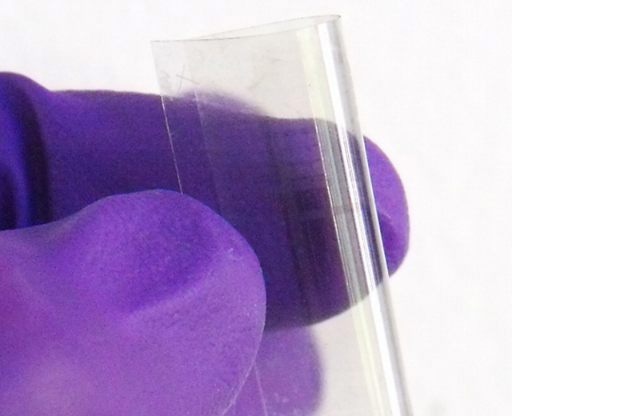Graphene, the "wonder material", is made of a single atom thick carbon atom layer in a honeycomb-like hexagonal lattice and is the thinnest, strongest and hardest material available. The last few years has seen extensive research into the properties and applications of graphene, and the material has been suggested as being an potential replacement for silicon in many electronics applications.
Graphene has several useful properties that include high mechanical strength, very high electron mobility, and superior thermal conductivity. The applications of graphene in various components of electronic devices are detailed below.

Graphene could be used to create electronic components which are transparent and flexible, creating a new paradigm in electronic product design. Image credit: Rice University News
Graphene in Batteries
There are a range of technologies available for energy storage, each having a number of tradeoffs in terms of capacity, weight and performance. Capacitors are quick to charge and lightweight, but do not have a large capacity. Batteries are capable of retaining more charge, but are heavy and take a long time to recharge. This variety is good as it offers a number of options to fine-tune a device to suit specific requirements.
Chinese researchers have developed a graphene foam-based battery design that may bridge the gap between batteries and capacitors. It is based on lithium technology, and even in experimental form has a similar capacity to weight ratio to existing lithium ion batteries. It can discharge and charge as quickly as a capacitor and can discharge completely in 20 seconds. It is also flexible, and works perfectly when it is bent.
California Lithium Battery (CalBattery) has worked in collaboration with Argonne National Laboratory (ANL) for the commercialization of an innovative lithium battery anode to be used with its new GEN3 silicon graphene composite anode materials to achieve new lithium ion battery performance levels.
Full cell tests showed excellent performance characteristics with a specific anode capacity of 1,250mAh/g and an energy density of 525WH/Kg. This is a more than 300% improvement in LIB capacity and 70% reduction in lifetime cost for batteries in consumer electronics, grid scale energy storage and EVs.
This novel battery material makes use of a new silicon-graphene production process developed by ANL. This new material is capable of working in a full lithium ion cell with a range of electrolyte and cathode materials. The excellent results of the ANL development program makes the company believe that this advanced anode material can substitute traditional graphite-based anode materials.
Graphene Electrodes for Touch Screens
Graphene film is a strong candidate for the replacement of indium tin oxide, which is a commercial product used extensively as a transparent conductor. It is used in touch screens on table computers and smartphones and is used as an electrode in solar cells and OLEDs.
One graphene-based thin film developed by Rice University researchers integrates a high-conductivity graphene single-layer sheet with a fine metal nanowire grid. According to researchers, the material outperforms ITO and other competing materials with lower resistance and higher transparency to electric current.
According to postdoctoral researcher Yu Zhu, fine metal meshes show excellent conductivity; however, gaps in the nanowires render them unsuitable as independent components in conductive electrodes.
Metal grids can be easily produced on a flexible substrate through standard techniques including ink jet and roll-to-roll printing. The transparent electrode designed by Rice researchers has higher conductivity than ITO and is flexible. The film is also eco-friendly and did not deteriorate easily.
Dream touch-screens from graphene at Rice University
Flexible, transparent electronics are closer to reality with the creation of graphene-based electrodes at Rice University. Run time - 2:38 min.
Transparent Memory with Graphene
Rice University researchers have succeeded in developing transparent flexible memory chips using silicon oxide as the active component.
The transparent memory technology is based on the 2010 discovery that pushing a strong charge through standard silicon dioxide, which is an insulator used commonly in electronics, strips oxygen atoms off the material, resulting in pure silicon crystal channels less than 5 nm wide.
In 2012, the Rice team used this phenomenon to create a two-terminal transparent memory device. After the initial large current creates the nanochannels, smaller charges can then be used to break or make the circuit to encode binary information, and a still smaller current can be used to check the state of the memory without changing it.
Integrated Circuits with Graphene Transistors
In June 2011, IBM researchers announced the design of a high-speed graphene circuit. In 2010, IBM produced a working transistor with graphene - a great achievement since graphene is not a natural semiconductor. Despite the technical challenges, this first working graphene transistor operated at twice the speed of a comparable silicon transistor.
A working transistor means nothing unless it is integrated into a circuit, implying that a number of transistors are linked to perform a task. In this instance, IBM scientists constructed a broadband radio frequency mixer that is used in radio applications to process signals at a range of frequencies. It is a standard IC component and this achievement shows that graphene transistors can be used effectively in more complex systems.
IBM overcame a number of challenges to make this possible, including protecting the ultra-thin graphene layer during the etching process with electron beam lithography, which is a standard process for creating nanoscale features in silicon-based electronics. Though this is in the prototype stage, if IBM is able to commercially produce graphene transistors, it will change the face of electronics.
Conclusion
Graphene is a promising material for new types of systems, circuits and devices where several functionalities can be combined into a single material.
Presently, highly critical issues with the extensive use of graphene in electronics are related to manufacturing. Although growth on copper surfaces has made bulk manufacture of large area graphene layers possible, there are a number of technical challenges to be overcome both in terms of cost and quality before the first consumer products using graphene are actually commercialized.
References